How To Get Rid Of A Hunched Neck
Many of my patients are concerned that they will develop a Dowager's Hump. As a result, I often get asked by patients, both young and old, how to prevent or how to get rid of Dowager's Hump.
How to Get Rid of Dowager's Hump
In this blog post on how to get rid of Dowager's Hump we cover several important topics:
- Definition.
- Causes.
- Symptoms.
- Can you experience pain?
- How to measure kyphosis.
- How can you avoid, prevent, treat or get rid of it?
- Should you use a brace?
- Are there sleeping positions or pillows that will help?
- Recommended exercises.
- Time to correct your posture.
Let's start with a definition of a Dowager's Hump.
This article was last updated on August 20, 2020
What is a Dowager's Hump
Dowager's Hump is not a term often used when I went through a Physical Therapy school. I looked the term up and it happens that a dowager is somebody like Violet Crawley — Lady Grantham in "Downton Abbey". Lady Grantham is formally known as Dowager Countess of Grantham, the widow of the Earl of Grantham.

The "hump" part of the term refers to the pronounced kyphosis that you see many women (perhaps Dowagers) have. As the elderly woman's posture deteriorated, a hump would develop on the back of their upper thoracic spine and became known as a Dowager's Hump.
Neck Hump or Buffalo Hump
You might also hear the terms neck hump or buffalo hump to describe a Dowager's Hump. Don't worry. They all refer to the same thing.
Hyperkyphosis
The proper medical term for Dowager's Hump is hyperkyphosis. Hyperkyphosis describes an excessive curvature of the thoracic spine. It is also known as hunchback. The accepted and current standard for the definition hyperkyphosis is a kyphosis angle in excess of 50 degrees.(1)
Dowager's Hump not necessarily associated with osteoporosis or spinal fusion. But it is something that many, many people worry about from as young as 15 years old to as old as 115 years old. People are concerned about their posture — and rightfully so.
I tell clients who are worried about Dowager's Hump, that they should be mostly just concerned about their posture. I instruct them on what to do to correct or optimize their posture and hopefully avoid Dowager's Hump or, in the case where people have progressed too far, reverse Dowager's Hump. We're going to cover that in more detail later in this blog post.
What Causes Dowager's Hump
That leads us into the next question my clients have: what causes Dowager's Hump. There are three major causes.
Poor Posture Habits
During the times of Downton Abbey, Dowager's Hump was brought on by aging and fatigue (and sometimes osteoporosis or poor posture). Today, Dowager's Hump is a result of the poor posture caused by stooping over devices (such as the iPhone), slouching in front of computers, sitting in soft chairs, and our laissez-faire attitude in schools and at dinner tables.

No longer are children or young people encouraged to sit up tall. It's quite common today to see people hanging out and young people sitting in a slouched position. The photo of the young woman to the right clearly shows the slouching position seen so often in day-to-day life — especially in light of new mobile devices.
These habits create significant challenges for you, and for us as Therapists, when you want to change and optimize your posture. This is because all of a sudden, the causes, which is just habitual slouching, become something that you need to habitually unlearn.
Compression Fractures
In the population I serve, I will see women who have had multiple compression fractures of their vertebrae. When that happens, then the vertebrae become wedged. The vertebrae no longer has a flat edge on each end, but rather the front of the vertebrae takes on that wedge shape. That wedge encourages the spine to take on that deformity or the Dowager Hump shape.

The photo above of the older gentleman (with his face obscured for privacy reasons) is someone with severe Dowager's Hump.
There are a few other medical conditions that are associated with the dowager's hump or the kyphotic posture but the major causes are poor posture and compression fracture.
What people tend to worry about is a big fatty pad that sometimes people will behind their neck. Well, the body is very intelligent. If you have to hold up an 11-pound head all day long, then the body is going to try to create more strength in this area by laying down more tissues. The fatty pad is your body's way of trying to deal with the forward head posture.
Scheuermann's Disease
Scheuermann's disease is a disease of the young that persists into adulthood. It develops in adolescence when the spine is growing. During this developmental period your spine fails to develop normally and you develop an exaggerated rounded mid or lower back (hunched back).
One third of people with Scheuermann's disease also develop scoliosis. Pain is a symptom that often appears later in the disease process. Difficulty bending backwards (doing upward dog pose or sphinx pose) is another symptom.
If you suspect that you or a person you love may have Scheuermann's disease, you should speak to your doctor. An X-ray will confirm the disease and Physiotherapy is recommended
How to Have a Perfect Posture
Posture is the foundation of all movement and exercise. This is why I developed the online course, Perfect Posture in 30 Days.
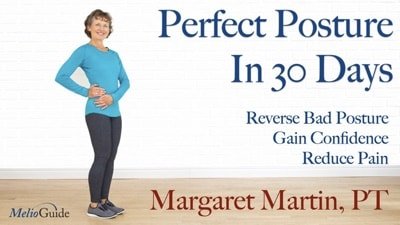
Perfect Posture
A perfect posture has many benefits.
- Reduces your risk of back, neck and shoulder pain.
- Improves balance and the reduces the chance of a fall.
- Promotes a positive self-image.
Posture and Osteoporosis
Good postural alignment is especially important for individuals with osteoporosis and low bone density.
Simple movements you do everyday can lead to small fractures to the spine.
For example, poor postural alignment when you cough, sneeze, or reach for something can cause micro trauma to the spinal column. Over time, these micro traumas can add up and eventually lead to vertebral compression fractures.
A poor posture contributes to balance issues. As a result, individuals with osteoporosis and low bone density are at risk of a macro trauma to the spine because of balance problems.
The Source of Poor Posture
Why don't more of us have a perfect posture? Because many of the activities we do in today's modern world involve forward flexion.
Activities such as reading in bed, using a mobile phone, gaming, texting, sitting for hours hunched over a laptop computer, knitting, crocheting, and many more encourage forward flexion.
Many people take this forward movement into their exercise and leisure activities. Unfortunately, this reinforces poor postural alignment.
Unless we make adjustments to our environment or correct our posture, over time we weaken and stretch certain muscles and tighten other muscles. This muscular imbalance leads to poor postural alignment.
We need to fix this imbalance, modify our movements so that we can get the posture we want.
How to Achieve a Perfect Posture
Many of us do not know how to get and keep a perfect posture. To have a good posture we need to learn the fundamentals of good posture, know what exercises promote postural alignment, and how to bring good posture into our day to day activities.
This is why I created Perfect Posture in 30 Days. This course addresses each of these areas and shows you how to develop a perfect posture, how to modify your daily activities, and how to make your perfect posture a permanent part of your life.
Perfect Posture in 30 Days will improve your posture, boost your confidence, and allow you to live a pain free life.

Dowager Hump Symptoms
How do you know if you have Dowager's Hump and what are the Dowager Hump symptoms you should be concerned about? Dowager Hump symptoms include:
- Shallow breathing.
- Problems breathing.
- Indigestion.
- Pelvic floor problems.
- Rotator cuff problems.
- Tennis elbow.
- Carpal tunnel.
- Neck problems.
- Jaw problems.
- Headaches.
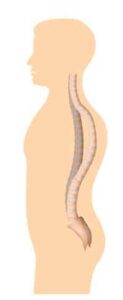
Stand Tall with Perfect Posture
One of the reasons I'm dressed like this (in the video) is to show you what happens when I alter my posture. Then you'll see some of the symptoms that people are concerned about.
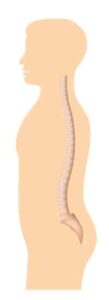
If I'm standing tall, my arms rest by my side. They're not resting in front of me. They're resting alongside my body.
I have a natural little arch at the small of my back, my mid-back is fairly flat, and I have a small arch in the back of my neck. My ear is lined up over the middle of my shoulder.
When I do that, my organs have lots of space to do what they love to do. I can take nice full breaths and open my ribs. This allows me to suck in my stomach, engage my deep core muscles, and support my pelvic floor.
Dowager Hump Symptoms from Poor Posture
When I hang out with my arms in front of me, it gets harder for me to be able to hold in my tummy. This in not an optimum posture and it is very tiring.
When you are in this posture, the ribs start pushing down and your liver, stomach, and all your intestines get crushed into a smaller smaller space.
This can cause Dowager Hump symptoms like:
- Shallow breathing.
- Poor indigestion.
- In addition, all this pressure makes it harder on your pelvic floor.
- The forward shoulder posture can cause rotator cuff problems, tennis elbow, and carpal tunnel problems.
- Dowager Hump can put pressure on the suboccipital muscles at the base of our skull and cause neck problems, jaw problems, and headaches.
There are studies that put healthy college-age students in this forward posture for 15 minutes. This brief and small change to their posture caused neck pain and headaches.
Dowager's Hump Pain
My clients often ask, "Should I worry about my poor posture and Dowager's Hump causing pain?" The answer is a definite yes. Dowager hump can lead to shoulder problems, tennis elbow, carpal tunnel, headaches, neck pain, and jaw pain.
Kyphosis Measurement for Dowager's Hump
How do you know for sure if you have Dowager's Hump or a poor posture? Is there an agreed-upon standard for kyphosis measurement that you or your Therapist can use to get the definitive answer?
There are sophisticated ways of kyphosis measurement with x-rays but that approach is generally not accessible to many people.
Fortunately, a group of researchers(2) recently had a very clever idea and found a simple way to measure kyphosis — our forward head posture — without expensive equipment. They developed a technique called hyperkyphotic measures using distance to wall.
How to Do the Kyphosis Measurement
Here is how they do a kyphosis measurement.
- Line up — heels, sacrum, mid-back, and as much as ahead as possible — flat against a wall.
- For purposes of today's video, we're just using the post here on my pulley system.
- If you're a clinician watching this, or if you want to do this for yourself, you could use a flat wall.
- You want to measure the distance between your C7 and the wall.
- How do you figure out where C7 is? Let's find C7.
- Take your index finger and place it down your neck.
- Come to one bony prominence, a bony bit here that sticks out more than the others — that's usually your first thoracic.
- Our spine goes from cervical to thoracic — so that's the first thoracic.
- Look for the last cervical or C7.
- Take your third finger and place it just above.
- As you bring your head down, and then bring your head back up, the bone that you were feeling should disappear underneath your fingers.
- If the bone disappears, that is your C7.
- That is what you're going to measure when you come up to the wall.
- Go up against the wall and feel the distance between your vertebrae and the post.
- I have roughly a finger width.
- Determine that width in centimetres.
Scoring the Kyphosis Measurement Results
Here are the guidelines to determine your level of kyphosis or Dowager's Hump:
- Very mild kyphosis is considered anything under five centimetres.
- Between 5.1 and eight was considered moderate.
- Eight centimetres or above is considered severe.
If you score between very mild to moderate, this would be an opportune time to start focusing on changing your alignment for the better. Because if you wait until it gets severe, and when that distance is more in the range of eight centimetres or more, then that also was shown to have a higher rate of fractures of the vertebrae.
This technique is useful for both clinicians and individuals because sometimes we lose track of what good posture is today because so many people have bad posture. This is one way for you to check in on yourself and go, "How is my posture doing today or this month?"
This kyphosis measurement technique is easy and accurate. Before the availability of this technique, we used to rely solely on measuring the distance between the head and the wall. Our goal is to encourage the lengthening or retraction of the neck and this new kyphosis measurement technique fits the bill. This is what we consider optimum alignment of the head and neck. We will cover that in more detail when we get to the exercise section in this post.
Dowager's Hump Treatment Options
What are the recommended treatments for fixing a Dowager's Hump or your bad posture?
I would like to say that you could do neck hump treatment all by yourself. And for the most part, if you're in the early stages of kyphosis (as measured by the kyphosis measurement technique described above), you certainly can.
But I would be doing a disservice to myself as a clinician, and all the other wonderful therapists out there if I said you didn't need our help.
Let's walk through some of the Dowager's Hump treatment options I recommend to my clients.
Neck Hump Treatment and How to Get Rid of Dowager's Hump
A manual Physical Therapist (therapists that use their hands) can use a number of treatment options to correct a Dowager's Hump and regain your good posture. These include:
- Myofascial release.
- Taping.
- Specific mobilization or movements of the vertebrae that have been stiff for a long time.
How to Avoid Dowager's Hump
There are a number of things that you can do to avoid a Dowager's Hump. We will cover these here. If your posture has already become kyphotic, these techniques will help considerably before your work with the manual therapist.
Sitting Posture
Time to talk about sitting posture.
When your knees are higher than your hips, it's very hard to sit up straight. When your knees higher than your hips it tilts your pelvis back, flattens your lower back. By flattening that nice little arch that once existed in the back, the rest of the back wants to fall forward and then the head follows.
The very first thing you can do to correct your sitting posture in sitting is to alter the surface that you're sitting on. Look at where your knees are relative to your hips.
I often have to sit on the edge of chairs. By doing so, my knees drop down below the height of my hips. That allows me to tilt my pelvis forward.
I can encourage that process a little bit more by rolling up a little blanket and placing it in underneath my sit bones.
Dyna Disc
There are also devices such as a Dyna Disc or a sit-in disc. They're inflatable discs that are actually covered in cloth or a little bit warmer fabric that you place under your pelvis to tilt your pelvis forward.
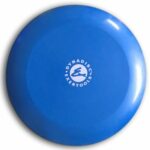 Each of these things encourage a re-creation or support of the little arch in the small of your back so that all of your vertebrae line up. This alignment then allows your head to come back over your shoulder.
Each of these things encourage a re-creation or support of the little arch in the small of your back so that all of your vertebrae line up. This alignment then allows your head to come back over your shoulder.
Soft Sofas
Another recommendation is not to use soft sofas because they don't have the proper support for your posture.
This leads us to driving. The seats in cars and planes are poorly designed for the human body. You have to use the same techniques I described to correct your posture when driving or flying.
Even though cars often come with lumbar rolls, they're frequently not in locations where your body needs them. You have to deflate the one in the car and bring your own lumbar roll.
Supports for Your Back While Sitting and Driving
There are a lot of different rolls you can purchase that support your back. Other low cost options include simply using
- A little scarf.
- Extra mittens in the wintertime.
- A paper towel roll.
Once you set your best sitting posture before starting to drive, adjust your rearview mirror so that it is your reminder that if you don't see behind you, then you've slouched back down.
How to Have a Perfect Posture
Posture is the foundation of all movement and exercise. This is why I developed the online course, Perfect Posture in 30 Days.

Perfect Posture
A perfect posture has many benefits.
- Reduces your risk of back, neck and shoulder pain.
- Improves balance and the reduces the chance of a fall.
- Promotes a positive self-image.
Posture and Osteoporosis
Good postural alignment is especially important for individuals with osteoporosis and low bone density.
Simple movements you do everyday can lead to small fractures to the spine.
For example, poor postural alignment when you cough, sneeze, or reach for something can cause micro trauma to the spinal column. Over time, these micro traumas can add up and eventually lead to vertebral compression fractures.
A poor posture contributes to balance issues. As a result, individuals with osteoporosis and low bone density are at risk of a macro trauma to the spine because of balance problems.
The Source of Poor Posture
Why don't more of us have a perfect posture? Because many of the activities we do in today's modern world involve forward flexion.
Activities such as reading in bed, using a mobile phone, gaming, texting, sitting for hours hunched over a laptop computer, knitting, crocheting, and many more encourage forward flexion.
Many people take this forward movement into their exercise and leisure activities. Unfortunately, this reinforces poor postural alignment.
Unless we make adjustments to our environment or correct our posture, over time we weaken and stretch certain muscles and tighten other muscles. This muscular imbalance leads to poor postural alignment.
We need to fix this imbalance, modify our movements so that we can get the posture we want.
How to Achieve a Perfect Posture
Many of us do not know how to get and keep a perfect posture. To have a good posture we need to learn the fundamentals of good posture, know what exercises promote postural alignment, and how to bring good posture into our day to day activities.
This is why I created Perfect Posture in 30 Days. This course addresses each of these areas and shows you how to develop a perfect posture, how to modify your daily activities, and how to make your perfect posture a permanent part of your life.
Perfect Posture in 30 Days will improve your posture, boost your confidence, and allow you to live a pain free life.

Dowager Hump Brace
It takes a lot of work to get a perfect posture. However, not everyone wants to make that commitment. Clients often ask me:
- Can I just use a Dowager Hump brace?
- Would a Dowager Hump correction brace help me?
A Dowager Hump brace is not a long term solution. While I prefer clients do neck hump exercises to strengthen their muscles and improve their posture, there are Dowager Hump braces that can help. They are appropriate if you have had a compression fracture. I have broken down the different options by degree of kyphosis.
Dowager Hump Brace for Minimal Kyphosis
Consider a rigid brace if have an acute vertebral fractures and minimal kyphosis. These two models meet this requirement:
- Truform Rigid Spinal Orthosis
- C.A.S.H. (Cruciform Anterior Spinal Hyperextension)
Dowager Hump Brace for Advanced Kyphosis
People with acute vertebral fractures and more advanced kyphosis should consider a semi-rigid support:
- Camp XXI Thoracolumbar Support
- Fast-Wrap Thoracolumbar Support
- Spinomed III
Dowager Hump Brace Alternatives
There are Dowager Hump brace alternatives that can remind you that your posture is less than perfect:
- A product such as a Lumo Lift, will beep or vibrate to remind you that you just slouched.
- Another trick is taping that makes you kinesthetically aware of your posture.
Dowager's Hump Correction Brace
I think that anything that gives you that reminder when you drift into your comfort zone and remind you to get back into good posture is worthwhile. I find that the younger you are, the faster you can get out of your comfort zone and back into good posture. However, it can take as long as three months to get back if you've been habitually slouching.
Keep in mind that that tool should only be used for short periods of time. A brace is exactly that — it's a brace. Technically, your muscles will actually get weaker if you use it and do not work on strengthening your postural muscles.
You ideally want to lengthen muscles that are in front, and strengthen muscles that are in back. And that's something we'll cover later on. But there are rules to play with braces especially when pain is involved. But use them under guidance and use them for short-term.
I wrote an article on posture aid recommendations and orthotic back braces that might be worth a read.
Support Bras and Breast Reduction
Many of my clients ask me about bras, something I don't have a lot of personal experience in. I used to worry but now that I'm in my late 50s, I'm really happy that I have small breasts.
I don't have a lot of experience, but I have had a lot of clients with big breasts. The extra weight of the breast does put a lot more demand on the mid-back. Provincial governments in Canada pay for breast reductions for women that are very large-breasted because it does cause chronic mid-back pain and neck pain.
I'm not an advocate of a breast reduction, but certainly, there is a role for that if that's a challenge that you have in your life.
Otherwise, I strongly encourage you to search out the proper support bra for yourself. I have many large-breasted clients who have found that perfect bra that has made a difference in their life. I encourage you to go that route if that's something that you need.
Dowager's Hump Pillow and Sleeping Position
Many people ask me to recommend a Dowager's Hump pillow and if I can recommend a Dowager's Hump sleeping position.
Dowager's Hump Pillow
We talked one of the symptoms of forward head posture being neck pain. Often, if you wake up in the morning or during the night and your neck pain is worse, then your pillow is definitely one of the contributing causes.
When we think about the optimum pillow or the support that we need when we're sleeping, a lot of it has to do with what position we sleep in. When we're sleeping on our back the only thing that needs support, if we have good alignment, is the arch and the small of our neck.
If we tend to have a bit of a forward head posture, we're going to need to support that space. Otherwise, our head is going to fall back. The more forward your head is, the more pillow you're going to need to support. But know that if you continually support yourself when you're lying on your back, you are never going to have an opportunity to actually get a little bit of a stretch and to gradually bring yourself back.
Dowager's Hump Sleeping Position
In many movies you always see the actor in bed with two big pillows. But this is terrible for the average person because it puts you back into the same head forward posture. Your spine never gets an opportunity to elongate.
If you're a back sleeper, try to minimize your pillows as much as possible, so that you have the support just in the small of your neck. You don't really need anything under your head.
But if your head is not yet comfortable going all the way flat, do use the smallest pillow you can under your head and still support your neck. Pillows should not be underneath your shoulders.
If you're a side sleeper, however, then you are going to want to have a pillow that allows you to fill in the space between your shoulder and your neck. A pillow that is little bit flatter in this situation works, and the other pillow can be used between your knees and ankles. you want your chin to line up in the middle of your breastbone.
I hope these tips help you have a better night's sleep and wake up pain-free.
How to Have a Perfect Posture
Posture is the foundation of all movement and exercise. This is why I developed the online course, Perfect Posture in 30 Days.

Perfect Posture
A perfect posture has many benefits.
- Reduces your risk of back, neck and shoulder pain.
- Improves balance and the reduces the chance of a fall.
- Promotes a positive self-image.
Posture and Osteoporosis
Good postural alignment is especially important for individuals with osteoporosis and low bone density.
Simple movements you do everyday can lead to small fractures to the spine.
For example, poor postural alignment when you cough, sneeze, or reach for something can cause micro trauma to the spinal column. Over time, these micro traumas can add up and eventually lead to vertebral compression fractures.
A poor posture contributes to balance issues. As a result, individuals with osteoporosis and low bone density are at risk of a macro trauma to the spine because of balance problems.
The Source of Poor Posture
Why don't more of us have a perfect posture? Because many of the activities we do in today's modern world involve forward flexion.
Activities such as reading in bed, using a mobile phone, gaming, texting, sitting for hours hunched over a laptop computer, knitting, crocheting, and many more encourage forward flexion.
Many people take this forward movement into their exercise and leisure activities. Unfortunately, this reinforces poor postural alignment.
Unless we make adjustments to our environment or correct our posture, over time we weaken and stretch certain muscles and tighten other muscles. This muscular imbalance leads to poor postural alignment.
We need to fix this imbalance, modify our movements so that we can get the posture we want.
How to Achieve a Perfect Posture
Many of us do not know how to get and keep a perfect posture. To have a good posture we need to learn the fundamentals of good posture, know what exercises promote postural alignment, and how to bring good posture into our day to day activities.
This is why I created Perfect Posture in 30 Days. This course addresses each of these areas and shows you how to develop a perfect posture, how to modify your daily activities, and how to make your perfect posture a permanent part of your life.
Perfect Posture in 30 Days will improve your posture, boost your confidence, and allow you to live a pain free life.

Dowager's Hump Exercises or Neck Hump Exercises
I have a comprehensive online course, Perfect Posture in 30 Days, dedicated to helping you improve your posture and fix your dowager's hump. I encourage you to check it out.
The postural exercises listed below are from Perfect Posture in 30 Days and are for Dowager's Hump or neck hump.
Dowager's Hump (Buffalo Hump / Neck Hump) Exercises
Exercises to get rid of buffalo hump or neck hump fall into two broad categories: stretching and strengthening exercises. I will give you a sample of some of the stretching exercises in this section. You can find the rest of the stretching exercises and the strengthening exercises in my online course, Perfect Posture in 30 Days.
Sternocleidomastoid Stretch
There are certain muscles that get particularly tight when we have a forward head posture. Before we can do the Dowager's Hump stretching exercises, we need to stretch these muscles.
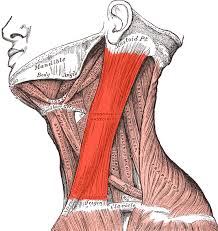 One of these is called the sternocleidomastoid — the mastoid process muscle. You will see this muscle when I turn my head. There is another branch of the sternocleidomastoid that goes down to the clavicle bone.
One of these is called the sternocleidomastoid — the mastoid process muscle. You will see this muscle when I turn my head. There is another branch of the sternocleidomastoid that goes down to the clavicle bone.
How to Locate the Sternocleidomastoid
How do you find the sternocleidomastoid? Here are the steps:
- Take your pulse with the opposite hand.
- Come down and find your pulse.
- Once you've found your pulse, replace your index and third finger with your thumb.
- Thumb goes in the place of your pulse.
- Push away from your pulse (you don't ever want a massage your pulse anywhere in your body).
- Turn your head a little bit more, and that muscle is going to come right into your thumb.
- Grab the other side of the muscle with your fingers.
- That gentle squeeze is all that muscle needs for a massage.
- If you squeeze it and it feels fine, you're going to move up the muscle, just follow that rope-like structure, all the way near your temporomandibular joint — your jaw.
- Come all the way up.
- Then you're going to work your way back down.
- Again, stay away from the pulse and work your way down the muscle.
- If there are spots that are somewhat painful, note that you can't hurt the muscle by squeezing it, but do respect the fact that you want to just create an intensity of about 5 out of 10.
- Throughout the day, go back and squeeze it 10 to 12 times and then leave it alone.
- Do this several times a day until you can get rid of all the tender spots in these muscles.
The sternocleidomastoid is one key muscle for you to work on.
Suboccipital Muscles Stretch
The next muscle you are going to stretch before you start your Dowager's Hump exercises is at the base of your skull. We're going to use balls on the floor.
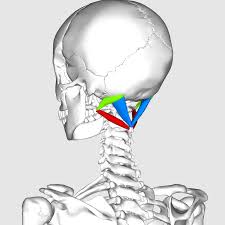
The little muscles at the base of the neck, the suboccipital muscles, get very tight from being in a forward head posture. When you try to stretch your neck, the muscles don't want to let go because they have little trigger points in them.
Here are the steps to stretch the suboccipital muscles:
- Place a small ball at the base of your skull.
- Rest your hands over the ball, and then gently move your head as though you're turning from side to side ever so slightly — that's probably the most comfortable.
- For some people, a little bit of a nod might do it on some of the side muscles.
- You just want to have enough pressure that you feel a gentle release in the muscles of the base of your neck.
Chin Tuck Stretch
Once those muscles feel released, the next stretch you can do for the little suboccipital muscles is the Chin Tuck stretch Dowager's Hump exercise. You draw your chin down towards the ground and you want to feel a lengthening in those muscles of the base of your skull.
Chest Stretch
The Chest Stretch Dowager's Hump exercise will open up the muscles of your chest that have been pulled forward.
- To open up your pec minor, have your hands up by your ears, and then breath in.
- As you exhale, bring your upper arms and forearms down towards the mat.
- Inhale back up.
- Exhale back.
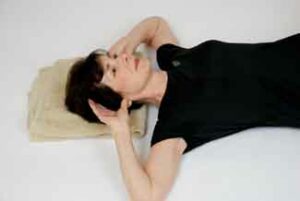
Pay Attention to the Small of Your Back
The reason I encourage people to incorporate their breath is that oftentimes if you're very tight, as you bring your arms back, your low back is going to want to take advantage of that space that is trying to give up.
Before you begin any of these postural exercises, you want to make sure that the space that's in the small of your back stays the same throughout the exercise.
Placing a little rolled towel, about the size of your hand, in the small of your back is really helpful. This support will keep your spine in its very best alignment the whole time that you do that exercise.
Pay Attention to the Placement of Your Head
Pay special attention to your head and its placement while doing the Dowager's Hump stretching exercises.
- If you find that when you lie flat on your back that your head wants to look back, then take as many towels as you need and fold them under your head until you have your very best posture.
- Focus on maintaining a nice alignment.
- Do not use more towels than you need because that's just going to put you back to where your head has been for too long.
- You're just trying to get a little tiny bit of a stretch while you're doing the exercise and keeping your alignment the whole time.
Arm Reach Stretch Exercise
Another great Dowager's Hump stretching exercise to increase the flexibility of the muscles that pull you forward is an Arm Reach. Here are the step-by-step instructions:
- Reach your arm behind you.
- Lengthen.
- All the while keep your spine straight.
- You can either reach with one arm, or you can reach with both arms simultaneously.
- Again, use the support that you need under your head.
- Some people like to do it as this overhead reach, whatever feels best for you.
Anything that starts to open your body up is a great way to start increasing the mobility through your mid-back and help you to regain some of the lost range.
Angel in the Snow Stretch Exercise
The last Dowager's Hump exercise I will cover is called an Angel Wings or Angel in the Snow stretch.
- Press your arms down as though you're creating an indentation in the snow, and you
- Continue to slide up.
- Keep your chin tucked.
- Keep that small space in the small of your back.
- As long as your arms stay in contact with the floor, keep sliding up.
- If you lose contact then that's as far as you go for this day and then come back down.
These are a few examples of the Dowager's Hump postural exercises that you'll find in Perfect Posture in 30 Days. Each exercise will help you work on improving your posture.
How Long Does it Take to Correct Dowager's Hump
Many people ask, "How long does it take to correct Dowager's Hump or fix bad posture? How long will it take before I get rid of my Dowager's Hump?"
The fact is that you didn't get tight and you didn't develop poor posture overnight. You should not expect to get straight overnight either.
I often give my clients the analogy of a book. If your head is forward by roughly 550 pages (as I demonstrate in the video) then you could imagine over a year and a half if you're diligent and consciously thinking about your posture and alignment, maybe you will reduce your forward head posture by one page width a day.
If you want quick results, that probably feels slow. But if you're only in your 20s, by the time you're still in your 20s, you'll have beautiful posture and a whole different outlook on how you feel, and how your body looks.
The longer you wait, the harder it is to make those corrections — but they're still possible.
How to Have a Perfect Posture
Posture is the foundation of all movement and exercise. This is why I developed the online course, Perfect Posture in 30 Days.

Perfect Posture
A perfect posture has many benefits.
- Reduces your risk of back, neck and shoulder pain.
- Improves balance and the reduces the chance of a fall.
- Promotes a positive self-image.
Posture and Osteoporosis
Good postural alignment is especially important for individuals with osteoporosis and low bone density.
Simple movements you do everyday can lead to small fractures to the spine.
For example, poor postural alignment when you cough, sneeze, or reach for something can cause micro trauma to the spinal column. Over time, these micro traumas can add up and eventually lead to vertebral compression fractures.
A poor posture contributes to balance issues. As a result, individuals with osteoporosis and low bone density are at risk of a macro trauma to the spine because of balance problems.
The Source of Poor Posture
Why don't more of us have a perfect posture? Because many of the activities we do in today's modern world involve forward flexion.
Activities such as reading in bed, using a mobile phone, gaming, texting, sitting for hours hunched over a laptop computer, knitting, crocheting, and many more encourage forward flexion.
Many people take this forward movement into their exercise and leisure activities. Unfortunately, this reinforces poor postural alignment.
Unless we make adjustments to our environment or correct our posture, over time we weaken and stretch certain muscles and tighten other muscles. This muscular imbalance leads to poor postural alignment.
We need to fix this imbalance, modify our movements so that we can get the posture we want.
How to Achieve a Perfect Posture
Many of us do not know how to get and keep a perfect posture. To have a good posture we need to learn the fundamentals of good posture, know what exercises promote postural alignment, and how to bring good posture into our day to day activities.
This is why I created Perfect Posture in 30 Days. This course addresses each of these areas and shows you how to develop a perfect posture, how to modify your daily activities, and how to make your perfect posture a permanent part of your life.
Perfect Posture in 30 Days will improve your posture, boost your confidence, and allow you to live a pain free life.

References
- Hyperkyphosis definition from spine-health.com. https://www.spine-health.com/glossary/hyperkyphosis
- Suwannarat P, et al, Hyperkyphotic measures using distance from the wall: validity, reliability, and distance from the wall to indicate the risk for thoracic hyperkyphosis and vertebral fracture., Arch Osteoporosis, 2018 Mar 12;13(1):25.
- The Trigger Point Therapy Workbook – Your Self-Treatment Guide for Pain Relief Authors:Clair and Amber Davies. 3rd edition.
- W. B. Katzman, E. Vittinghoff, F. Lin, A. Schafer, R. K. Long, S. Wong, A. Gladin, B. Fan, B. Allaire, D. M. Kado and N. E. Lane, Targeted spine strengthening exercise and posture training program to reduce hyperkyphosis in older adults: results from the study of hyperkyphosis, exercise, and function (SHEAF) randomized controlled trial, Osteoporosis International, 10.1007/s00198-017-4109-x, 28, 10, (2831-2841), (2017).
- Greendale, Gail, et al., Yoga Decreases Kyphosis in Senior Women and Men with Adult‐Onset Hyperkyphosis: Results of a Randomized Controlled Trial, 28 August 2009, Journal of the American Geriatrics Society
- Cho J, et al., Upper thoracic spine mobilization and mobility exercise versus upper cervical spine mobilization and stabilization exercise in individuals with forward head posture: a randomized clinical trial, BMC Musculoskeletal Disorder, 2017; 18:525
- Shih HS, et al, Effects of Kinesio taping and exercise on forward head posture., J Back Musculoskeletal Rehabilitation, 2017; 30(4): 725-733
Perfect Posture and Postural Alignment
I have a page dedicated to Perfect Posture. You can find information on how to get that perfect posture. For those of you interested in dedicated Physiotherapy, I also offer one-on-one Physical Therapy postural alignment through my Posture Alignment Therapy.
How To Get Rid Of A Hunched Neck
Source: https://melioguide.com/perfect-posture/dowagers-hump/
Posted by: reyhithorable.blogspot.com

0 Response to "How To Get Rid Of A Hunched Neck"
Post a Comment